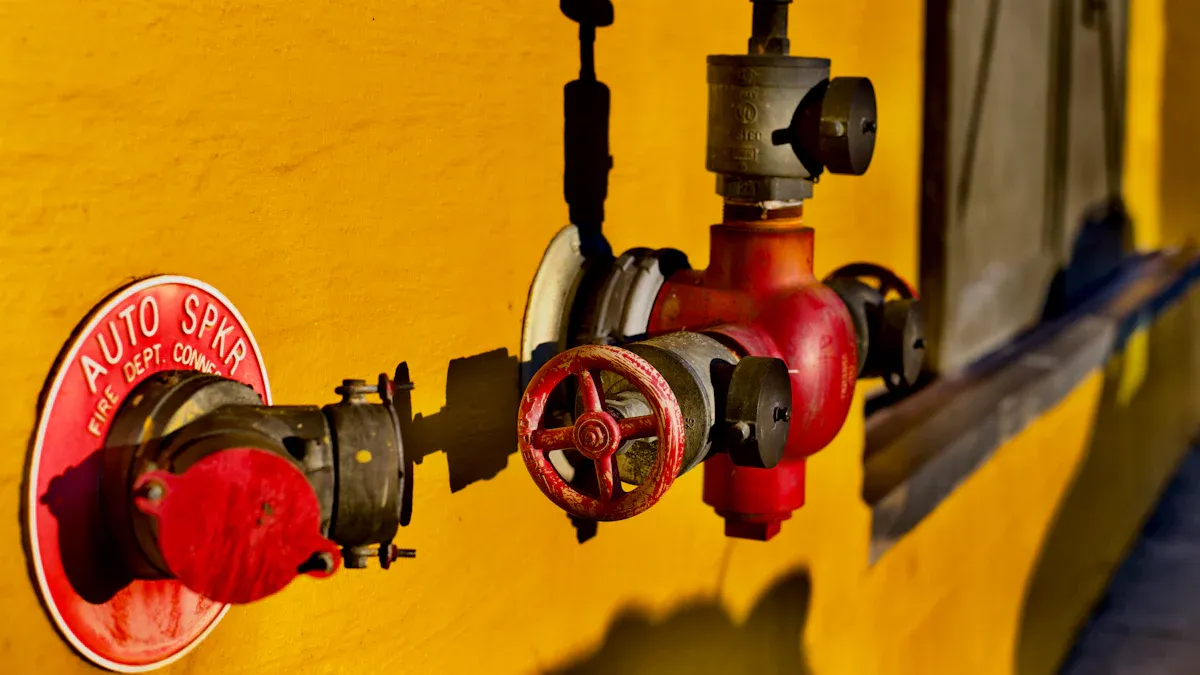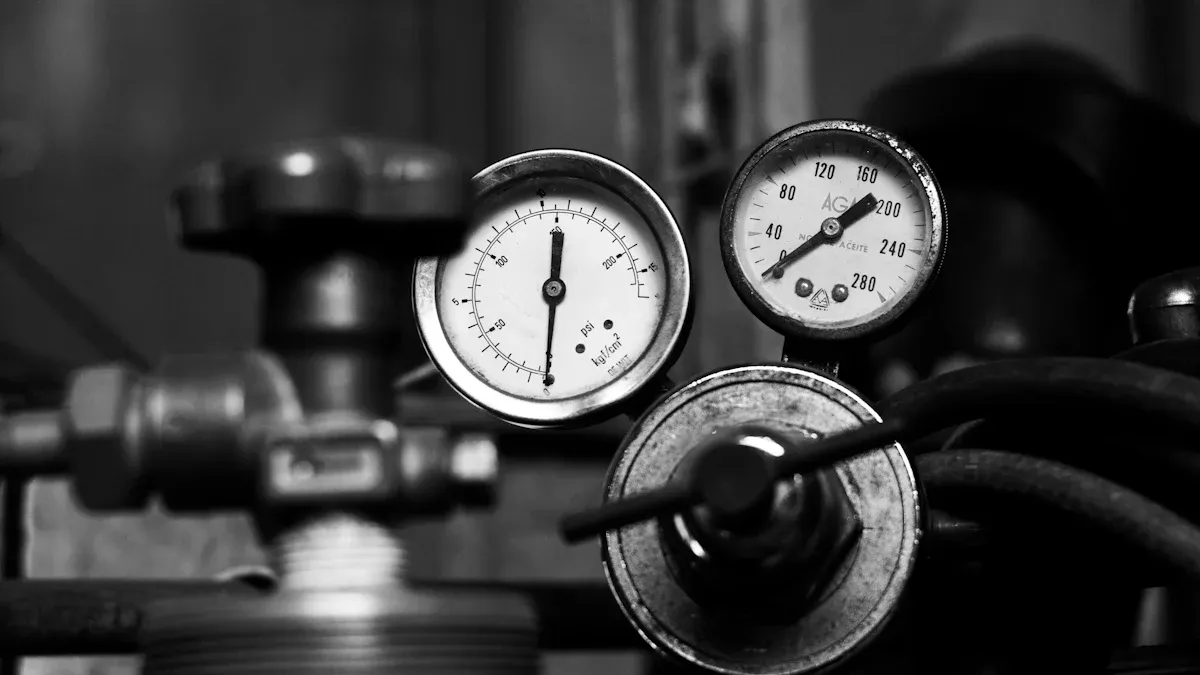 The Coupling Landing Valve operates at a pressure between 5 and 8 bar (about 65–115 psi). This pressure helps firefighters use hoses safely and effectively. Many buildings use the Fire Hydrant Landing Valve to keep water ready for emergencies. Factors like Coupling Landing Valve price can change based on quality and pressure requirements.
The Coupling Landing Valve operates at a pressure between 5 and 8 bar (about 65–115 psi). This pressure helps firefighters use hoses safely and effectively. Many buildings use the Fire Hydrant Landing Valve to keep water ready for emergencies. Factors like Coupling Landing Valve price can change based on quality and pressure requirements.
Proper pressure at the valve supports building safety and meets important regulations.
Key Takeaways
- The Coupling Landing Valve works best at a pressure between 5 and 8 bar (65–115 psi) to ensure safe firefighting.
- Following safety codes and regular maintenance keeps the valve pressure reliable and meets important fire safety rules.
- Building height, water supply strength, and valve design all affect the pressure at the valve and must be planned carefully.
- Technicians should check valve pressure regularly using a gauge and adjust it safely to keep the system ready for emergencies.
- Proper pressure helps firefighters get enough water quickly, supporting fast and safe fire control.
Coupling Landing Valve Pressure Range

Standard Values and Units
Engineers measure the pressure at the Coupling Landing Valve in bar or pounds per square inch (psi). Most systems set the pressure between 5 and 8 bar. This range equals about 65 to 115 psi. These values help firefighters get enough water flow during emergencies.
Tip: Always check the pressure units on equipment labels. Some countries use bar, while others use psi.
Here is a simple table showing the standard values:
| Pressure (bar) | Pressure (psi) |
|---|---|
| 5 | 72.5 |
| 6 | 87 |
| 7 | 101.5 |
| 8 | 116 |
Codes and Regulations
Many countries have rules for the Coupling Landing Valve. These rules make sure the valve works well in a fire. For example, the National Fire Protection Association (NFPA) in the United States sets standards for fire hydrant systems. In India, the Bureau of Indian Standards (BIS) gives similar rules. These codes often require the valve to keep a pressure between 5 and 8 bar.
- NFPA 14: Standard for the Installation of Standpipe and Hose Systems
- BIS IS 5290: Indian Standard for Landing Valves
Fire safety inspectors check these codes during building inspections. They want to see that the Coupling Landing Valve meets all safety rules.
Product Specifications
Manufacturers design each Coupling Landing Valve to handle a certain pressure. The product label or manual lists the maximum and minimum working pressures. Some valves have extra features, like pressure gauges or automatic pressure regulators. These features help keep the pressure steady.
When choosing a valve, building managers look at:
- Maximum working pressure
- Material strength
- Size of the valve
- Extra safety features
Note: Always match the valve’s specifications with the building’s fire safety plan.
Coupling Landing Valve Pressure Regulation
Inlet Pressure Influence
The water supply entering the system affects the pressure at the valve. If the inlet pressure is too low, firefighters may not get enough water flow. High inlet pressure can cause damage to hoses or equipment. Engineers often check the main water supply before installing a Coupling Landing Valve. They want to make sure the system can deliver the right amount of pressure during an emergency.
Note: City water mains or dedicated fire pumps usually provide the inlet pressure. Regular testing helps keep the system reliable.
Valve Design and Settings
The design of the valve plays a big role in pressure regulation. Some valves have built-in pressure-reducing features. These features help keep the pressure within a safe range. Manufacturers set the valve to open or close at certain pressures. This setting protects both the equipment and the people using it.
- Pressure-reducing valves lower high inlet pressure.
- Pressure-sustaining valves keep a minimum pressure in the system.
- Adjustable valves allow changes to the pressure setting as needed.
Each building may need a different valve design based on its fire safety plan.
System Components
Several parts work together to control the pressure at the valve. Pipes, pumps, and gauges all play important roles. Pumps boost water pressure when the supply is not strong enough. Gauges show the current pressure so users can monitor it easily. Pipes must be strong enough to handle the pressure without leaking.
A typical fire protection system includes:
- Water supply (main or tank)
- Fire pump
- Pipes and fittings
- Pressure gauges
- The Coupling Landing Valve
Tip: Regular inspection of all system components helps prevent pressure problems during an emergency.
Factors Affecting Coupling Landing Valve Pressure
Building Height and Layout
Building height changes the pressure at the valve. Water pressure drops as it moves up to higher floors. Tall buildings need stronger pumps to keep the right pressure at each Coupling Landing Valve. The layout of the building also matters. Long pipe runs or many turns can slow water flow and lower pressure. Engineers plan the pipe routes to reduce these problems. They place valves in spots where firefighters can reach them quickly.
Tip: In high-rise buildings, engineers often use pressure zones. Each zone has its own pump and valves to keep steady pressure.
Water Supply Conditions
The main water supply affects how much pressure reaches the valve. If the city water supply is weak, the system may not work well during a fire. Some buildings use storage tanks or booster pumps to help. Clean water lines keep the system working at its best. Dirty or blocked pipes can lower pressure and slow water flow.
- Strong water supply = better pressure at the valve
- Weak supply = risk of low pressure during emergencies
A steady and clean water source helps the fire system stay ready at all times.
Maintenance and Wear
Regular checks keep the system safe. Over time, pipes and valves can wear out or get blocked. Rust, leaks, or broken parts can lower the pressure at the valve. Building staff should inspect the Coupling Landing Valve and other parts often. They should fix any problems right away. Good maintenance keeps the fire system ready for emergencies.
Note: A well-maintained system gives firefighters the pressure they need to fight fires quickly.
Checking and Adjusting Coupling Landing Valve Pressure

Measuring Pressure
Technicians use a pressure gauge to check the pressure at the Coupling Landing Valve. They attach the gauge to the valve outlet. The gauge shows the current water pressure in bar or psi. This reading helps them know if the system meets safety standards. Many buildings keep a log of these readings for regular checks.
Steps to measure pressure:
- Close the valve before attaching the gauge.
- Connect the gauge to the valve outlet.
- Open the valve slowly and read the gauge.
- Record the pressure value.
- Remove the gauge and close the valve.
Tip: Always use a calibrated gauge for accurate results.
Adjusting or Regulating Pressure
If the pressure is too high or too low, technicians adjust the system. They may use a pressure-reducing valve or a pump controller. Some valves have built-in regulators. These devices help keep the pressure within the safe range. Technicians follow the manufacturer’s instructions for each adjustment.
Common ways to adjust pressure:
- Turn the regulator knob to increase or decrease pressure.
- Adjust the fire pump settings.
- Replace worn parts that affect pressure control.
A steady pressure helps the Coupling Landing Valve work well during emergencies.
Safety Considerations
Safety comes first when checking or adjusting valve pressure. Technicians wear protective gloves and goggles. They make sure the area stays dry to prevent slips. Only trained staff should handle these tasks. They follow safety rules to avoid injury or equipment damage.
Note: Never adjust the valve when the system is under high pressure without proper training.
Regular checks and safe practices keep the fire protection system ready for use.
The Coupling Landing Valve usually operates between 5 and 8 bar. This pressure range follows important safety standards. Regular checks help keep the system ready for emergencies. Building managers should always follow the latest codes.
Keeping the right pressure supports fast and safe firefighting.
- Regular maintenance ensures reliable operation.
- Proper pressure helps meet safety rules.
FAQ
What happens if the pressure at the Coupling Landing Valve is too low?
Low pressure can stop firefighters from getting enough water. This makes it hard to control a fire. Buildings must keep the right pressure to help firefighters work safely.
Can the Coupling Landing Valve handle high water pressure?
Most valves can handle up to 8 bar (116 psi). If the pressure goes higher, the valve or hose might break. Always check the valve’s label for its maximum pressure rating.
How often should someone check the valve pressure?
Experts recommend checking the valve pressure at least once every six months. Some buildings check more often. Regular checks help keep the system ready for emergencies.
Who can adjust the pressure at the Coupling Landing Valve?
Only trained technicians should adjust the pressure. They know how to use the right tools and follow safety rules. Untrained people should not try to change the settings.
Does the valve pressure change on different floors?
Yes, pressure drops on higher floors. Engineers use pumps or pressure zones to keep steady pressure at each valve. This helps firefighters get enough water anywhere in the building.
Post time: Jun-16-2025

